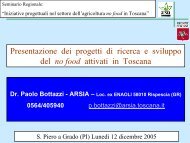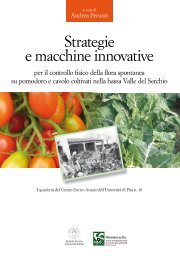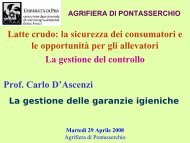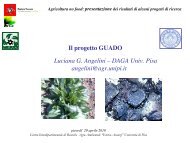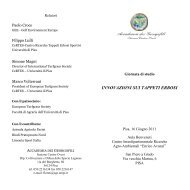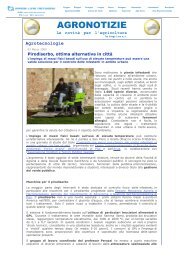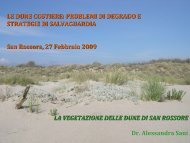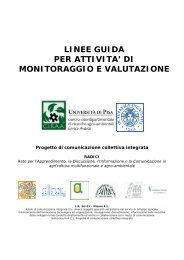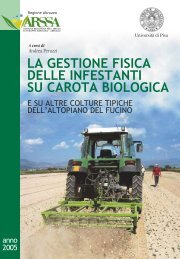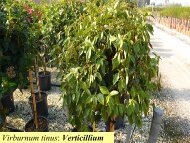Le colture dedicate - Centro Interdipartimentale di Ricerche Agro ...
Le colture dedicate - Centro Interdipartimentale di Ricerche Agro ...
Le colture dedicate - Centro Interdipartimentale di Ricerche Agro ...
Create successful ePaper yourself
Turn your PDF publications into a flip-book with our unique Google optimized e-Paper software.
66 QUADERNO ARSIA 6/2004<br />
Tab. 4 - Caratteristiche produttive <strong>di</strong> alcune specie annuali<br />
Specie Biomassa (s.s.) (t/ha) Potere calorico* (MJ/kg) Contenuto energetico (MJ/ha)<br />
Helianthus tuberosus 25,6 15,1 386,6<br />
Hibiscus cannabinus 18,6 15,3 284,6<br />
Kochia scoparia 26,7 14,7 392,5<br />
Pennisetum americanum 23,5 14,6 343,1<br />
Sorghum bicolor 28,2 16,4 462,5<br />
Sorghum vulgare 30,2 16,0 483,2<br />
* Il potere calorico del carbone è 27,4 MJ/ kg. Fonte: da Angelini et al., 1999.<br />
Tab. 7 - Temperatura <strong>di</strong> fusione delle ceneri<br />
<strong>di</strong> alcune biomasse vegetali<br />
T iniziale (°C) T fluida (°C)<br />
Cynara cardunculus 1221 1265<br />
Miscanthus sinensis 1004 1074<br />
Arundo donax 1016 1034<br />
Sorghum bicolor 1030 1059<br />
Carbone 1180 1450<br />
Fonte: Angelini et al., 1994.<br />
Tab. 5 - Caratteristiche della produzione <strong>di</strong> alcune specie poliennali da biomassa<br />
Specie Biomassa (s.s.) (t/ha) Potere calorico* (MJ/kg) Contenuto energetico (MJ/ha)<br />
Arundo donax 36,4 16,7 607,9<br />
Cynara cardunculus 14,8 14,1 208,7<br />
Miscanthus sinensis 37,4 16,9 632,1<br />
Panicum maximum 17,0 15,1 256,7<br />
Panicum virgatum 11,0 15,2 167,2<br />
* Il potere calorico del carbone è 27,4 MJ/ kg. Fonte: Angelini et al., 1999.<br />
Tab. 6 - Analisi elementare ed imme<strong>di</strong>ata delle biomasse <strong>di</strong> specie annuali e poliennali<br />
Analisi elementare Analisi imme<strong>di</strong>ata<br />
C H N S O Potere calorico MV CF MV/CF ceneri<br />
% % % % % MJ/kg % % % %<br />
C. cardunculus 39,0 6,6 0,5 0,2 52,8 14,1 72,9 13,1 5,6 13,9<br />
M. sinensis 42,5 7,6 0,1 0,1 49,7 16,9 77,2 20,0 3,9 2,8<br />
A. donax 42,7 7,5 0,8 0,2 48,7 16,7 75,2 19,8 3,8 5,0<br />
H. tuberosus 40,0 8,2 0,6 0,1 51,1 16,2 73,2 19,9 6,7 6,9<br />
H. cannabinbus 39,6 7,9 1,2 0,2 51,2 16,3 76,0 18,3 4,2 5,6<br />
K. scoparia 40,1 8,1 0,8 0,2 50,8 15,9 75,5 17,7 4,3 6,8<br />
P. americanum 39,7 7,7 0,9 0,2 51,6 15,2 72,9 19,0 3,8 7,8<br />
S. bicolor 40,3 7,6 0,5 0,1 51,4 15,8 74,5 19,9 3,8 5,6<br />
Carbone 74,2 4,2 1,3 0,5 19,8 27,4 24,2 60,6 0,4 14,2<br />
Mv = materie volatili; CF = carbonio fisso. Fonte: Angelini et al., 1999.<br />
quelli reperiti in bibliografia, alcuni dei fondamentali<br />
risultati acquisiti fino a oggi nel corso della sperimentazione<br />
da noi <strong>di</strong>rettamente condotta nella pianura<br />
litoranea pisana, in primo luogo presso il <strong>Centro</strong><br />
<strong>Inter<strong>di</strong>partimentale</strong> <strong>di</strong> <strong>Ricerche</strong> <strong>Agro</strong>ambientali<br />
“E. Avanzi” dell’Università <strong>di</strong> Pisa, a partire dai<br />
primi anni novanta, con finanziamenti <strong>di</strong> <strong>di</strong>versa provenienza,<br />
e in buona parte ancora in corso.<br />
Durante lo svolgimento delle ricerche <strong>di</strong> cui<br />
sopra, che <strong>di</strong> volta in volta hanno riguardato sia la<br />
scelta delle specie (e delle varietà), sia gli elementi




